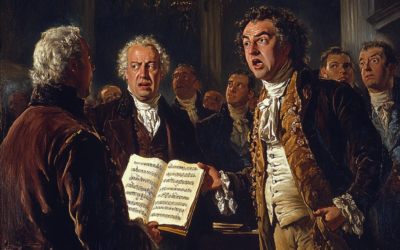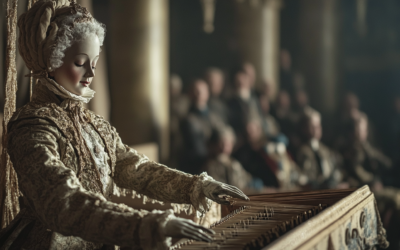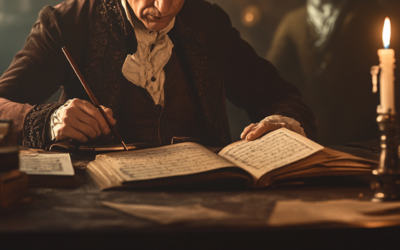Dissecting the Flaws in the Portrait and the Music That Wasn't
The Curious Case of Mozart's Phantom Sonata
In a striking case of artistic misattribution, the Musikwissenschaft has rediscovered Mozart through a portrait, attributing a dubious composition to him based solely on a score’s presence. One has to wonder: is this music really Mozart’s, or just a figment of our collective imagination?
Mozart: The Fall of the Gods
This book offers a fresh and critical look at the life of Wolfgang Amadeus Mozart, challenging the myths that have surrounded him for centuries. We strip away the romanticised image of the “natural genius” and delve into the contradictions within Mozart’s extensive biographies. Backed by nearly 2,000 meticulously sourced citations, this work invites readers to explore a deeper, more complex understanding of Mozart. Perfect for those who wish to question the traditional narrative, this biography is a must-read for serious music lovers and historians.
"In the curious case of Mozart's phantom sonata, standing next to a score doesn’t make you a composer—though it does make for a rather amusing tale!."
Mozart: The Fall of the Gods
In a rather amusing twist, the Musikwissenschaft has unearthed a portrait of the young Mozart from his first trip to Italy, only to attribute a composition to him based on nothing more than the appearance of a score in the painting. As if by mere proximity, the child at the harpsichord was anointed a composer! It begs the question: does standing next to a painting of a lion make one a wildlife expert?
The artist behind this questionable portrayal remains shrouded in mystery. Initially thought to be Saverio Dalla Rosa, some now suspect Giambettino Cignaroli may have been at the easel, perhaps in a fit of familial collaboration. Leopold Mozart’s letters provide tantalising yet scant details, revealing that the portrait was executed in just two sittings. One can’t help but wonder if it was more of a rush job than a masterpiece. Leopold mentions the commission but neglects to comment on the music—surely an oversight for such a “historic” moment.
Constanze Mozart, in a later letter, claims knowledge of two portraits of her husband but dances around the specifics like a skilled diplomat. When the painting reappeared in 1856, it was as if a ghost had emerged from the shadows, yet doubts about its connection to Mozart linger like an unwelcome dinner guest.
Perhaps the most outrageous aspect of this story is the complete absence of the original manuscript, signature, date, and any watermarks. It’s almost as if the piece of music existed solely as a clever ruse! The score displayed on the harpsichord doesn’t fit into any known repertoire of Mozart’s; rather, it seems to be an elaborate game of “Who’s That Composer?” with Mozart holding a losing hand.
The notion that this portrait serves as a “souvenir” is equally entertaining. In the 18th century, it was all the rage to immortalise oneself alongside notable props—like an instrument that screams, “Look at me, I’m a musician!” It seems likely that the choice of a score was more about enhancing the subject’s artistic pedigree than about accurately representing his works. Perhaps a piece by Baldassare Galuppi was standing in for Mozart, reminding us that context is everything—unless, of course, you’re trying to score a few points in the grand game of music history.
In summary, the absence of the original manuscript, signature, date, and watermarks raises serious questions about the authenticity of the music attributed to Mozart in this whimsical portrait. The conflation of a young genius’s image with an unverified composition serves as a stark reminder that, sometimes, our romantic notions of history can lead us down a rabbit hole of misattribution. If only it were as simple as being in the right place at the right time!
You May Also Like
When the Myth Collapsed
Vienna exposed the myth: La Finta semplice was riddled with errors, and Wolfgang’s supposed opera genius was nothing more than Leopold’s fabrication. With their reputation in ruins, father and son turned to Italy, hoping to rewrite history.
The London Notebook and the Vienna Disaster
Far from the myth of a flawless young genius, Mozart’s London Notebook reveals musical struggles and guided exercises, while the Vienna opera disaster proved that his father played a far greater role in his compositions than legend would have us believe.
Versailles, Vanity, and the Pursuit of Prestige
Leopold Mozart’s letters transformed his son’s European tour into a carefully staged fantasy—filled with exaggerated encounters, fabricated royal admiration, and a relentless pursuit of social prestige. But how much of it was real?
The Fabricated Childhood of Mozart
The legend of young Mozart’s divine genius crumbles under scrutiny, revealing a childhood dictated by Leopold’s ambition, carefully constructed myths, and a relentless pursuit of fame at the expense of genuine artistic education.
The Man Behind the Myth
Leopold Mozart’s legacy has been shaped by myths and hagiographies, but his letters reveal a man more concerned with financial gain and self-promotion than artistic integrity. Was he truly a devoted father, or simply an opportunist?
Constanze vs. The Catholic Church
For over two centuries, scholars have debated the circumstances surrounding Mozart’s burial. Constanze Mozart’s supposed inability to mark his grave, the confrontation with the Catholic Church over funeral masses, and the baffling disappearance of Mozart’s body all contribute to a mystery stranger than fiction. Did a powerful group keep her silent? And what really happened to Mozart’s remains?







